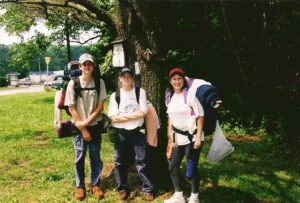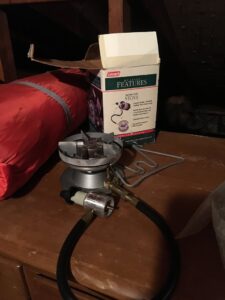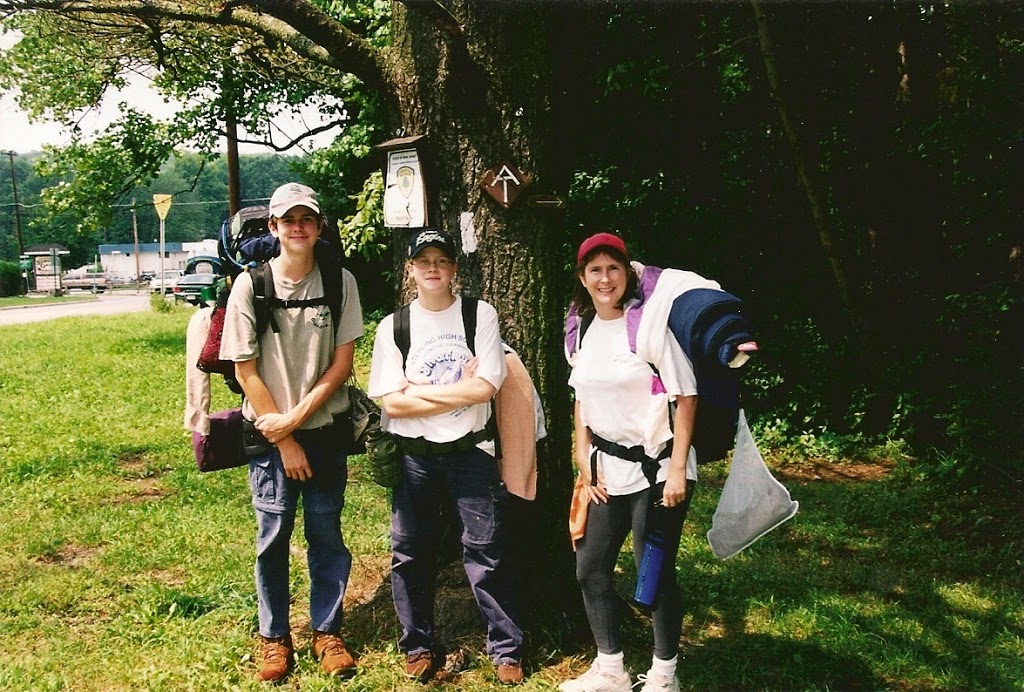As a rule, hikers shouldn’t drink untreated wild water in streams or springs unless the water source has been marked as “potable,” or drinkable, either on a map you have or by a sign posted at the site. If you are unsure, it’s better NOT to drink water found in the wild in streams or lakes. Even though it looks clear, there may be bacteria that we can’t see that can cause diseases in people, especially young children. It’s never worth the risk.
There is much to know when hiking in the backcountry, but for this post, I’ll just concentrate on clean drinking water.
 |
| Ready to begin a section of the Appalachian Trail! |
If you are hiking a continuous trail or the trail crosses a roadway or state border, sometimes “friends of thru-hikers” will leave huge water jugs for hikers to replenish their hydration packs. They do this for the Appalachian Trail [AT] on the East Coast of the United States. My son and daughter and I have done a few days backpacking the AT and have come across these fresh drinking jugs. They are too heavy to carry on the trail. That’s why the water jugs are located at crossroads. Canned foods with pull tops could be left there as well, but nothing fresh or opened so as to attack animals. The cans can be used as “pots” to boil water in.
Let’s talk about methods to purify drinking [and cooking] water while hiking long distances or hiking into the backcountry. As a backpacker, you should be carrying a few things to make the purifying of water possible. A lightweight aluminum pot and dry matches or small lighter for starters.
Boiling water is the easiest method to purify any wild water you find. According to the Centers for Disease Control [CDC] website, you should bring water to a rolling boil and let it boil for a full minute before drinking or cooking with it. Boil the water for three minutes at higher altitudes, CDC says.
 |
| Our Coleman low profile propane stove. |
Use one of those little one-burner, lightweight trail stoves to boil the water. Depending on the stove you have, you’ll need a fuel source; sterno, fuel pellets, or small propane bottle. We use a Coleman low profile propane stove. It’s heavier than this three inch mini backpacking stove I found online that uses a butane propane mix for fuel.
We also have a caldera cone where we can build a small fire to heat water. This caldera cone blocks the wind and holds the heat against the cooking surface better. We use sticks to make the fire inside the cone. You can also use sterno fuel. Our cone is old, but here’s a link to a whole new caldera cone stove system.
If you don’t have a one-burner stove or a caldera cone, you’ll need to build a small fire in a clearing if possible. If you’re in a wooded area, use dry sticks and leaves. Surround any fire with rocks or dig a pit and bank the dirt around the sides. Be aware of any strong breeze and make that side of your fire higher to block the wind. Once the flames die down a bit, set a pot on or against the heat to boil. Or place larger logs on the rocks as a grill and place pot on top.
Always make sure fires are out before going to sleep or moving on from the area. Smother them with dirt or sand depending on where you are building them. If you have extra water, douse the fire to be sure it is fully out.
Filtration is another good choice to purify water when backpacking in the wild or hiking long distances according to the CDC. Filtration kits can be used to reduce “pathogens” for “most microorganisms, depending on the pore size of the filter.” I must admit, I don’t have a filtration kit. We never backpacked for long periods of time. Not with all five kids. But I found a quick drink filtration kit online. It’s called a Life Straw.
“Disinfection can be used as a pathogen reduction method against microorganisms…” the CDC says. I found the information on Potable Aqua iodine tablets’ website helpful in disinfecting water found in the wild.
Water filtration kits come in handy when hiking the back country or hiking long distances if you can’t boil the water. You should filter the water first and then disinfect the water following the manufacturer’s instruction on the tablets to rid it of other contaminants according to the CDC.
The whole reason to go camping with the family is to enjoy each other’s company while traveling and seeing this beautiful world of ours. Have fun on your next camping or hiking adventure, no matter where you go. Feel free to share any tips you may have on how to purify drinking water. Just leave a note in the comments section here at Camping with Five Kids. It would be truly appreciated. Enjoy your adventure!


Very interesting. I didn't realize they had different equipment to purify water. That sounds like a great idea if you are hiking for a long time. Great post as always.
It's always a pleasure seeing you here at Camping With Five Kids, Michelle. It's amazing what they have out now to purify water. I barely scratched the surface in this post. Of course I was concentrating on what you had to carry into the wild. I was considering weight and complexity.
Thanks so much for your kind note at Camping With Five Kids. Enjoy your weekend and be safe!
Fine writing ! Thank you so much for sharing this beautiful blog. It's clean, engaging and very very enjoyable. Keep writing as I am waiting for your next.Bruce Peninsula Ontario Campgrounds
https://kilsythcamping.blogspot.com/2020/01/do-most-fascinating-things-at-natures html
Have a great day! You may love to read this blog too –
Hello and welcome to Camping with Five Kids! I'm so glad you stopped by and left a note. It's greatly appreciated. Thank you for your kind words.
I'll check out your website. Thanks again for your note here at Camping with Five Kids. All best to you!
Great article
yala safari camping srilanka
Hello and welcome to Camping with Five Kids! I'm so glad you stopped by and left a note. It's greatly appreciated. Thank you for your kind words.
I'll check out your website. Thanks again for your note here at Camping with Five Kids. All best to you!
Such a nice writing. The style you have narrated is simple beautiful and well authored. The quality of writing can be seen from the beginning until the end.
Cottage/cabins rental Sauble Beach
Hello and welcome to Camping with Five Kids! I'm so glad you stopped by and left a note. It's greatly appreciated. Thank you for your kind words.